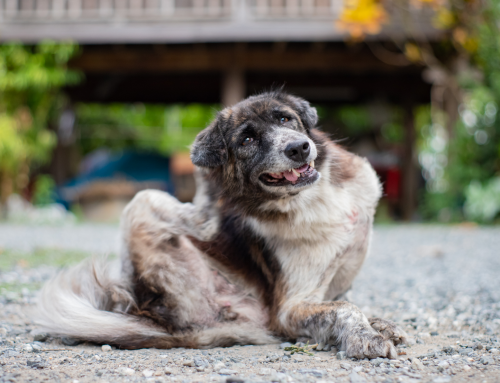One of the causes of dermatitis, or an itchy dog can be a food allergy or sensitivity. We dont know why some dogs react to foods while others dont but when they do it can cause quite a bit of discomfort. Food should be harmless but for unknown reasons some dogs will react to specific food proteins. This phenomenon tends to be more common in young dogs but can occur at any age, so just because your dog has eaten the same food for years, does mean that you can rule out food allergy as the source of his discomfort.
A dog must be exposed to a specific food protein in order to produce an allergic reaction. During the time that your dog is developing allergies, each food that he eats is a potential allergen. That is why dog foods with a very wide number of ingredients can be a nightmare for the allergic dog. The more food a dog is exposed to while developing allergies the more foods it will potentially be allergic to and the more difficult it is to find a novel food source to feed which will not produce an allergic reaction. If you suspect that your dog has a food allergy please do not change his/her food without consulting your veterinarian first.
Although severe anaphylactic reactions to food can occur in dogs it is extremely rare. Chronic red, itchy skin is the most common symptom. The skin may also become thickened and ears may be infected. Food allergy symptoms occur year round and do not change seasonally unless the diet is changed.
Symptoms:
- Red skin
- Itchy skin
- Thickened skin
- Ear infections
- Year round symptoms
- Soft stool
- Vomiting
- Anal sac disease
Your dog may experience only one or many of these symptoms.
The most common areas of the skin affected include:
- face
- ears
- belly
- underarms
- lower legs
- between the toes
These areas are not exclusive to food allergy though and so it is important to receive a diagnosis by a veterinarian.

To test for food allergies a food elimination trial is performed. To do this a food containing ingredients which your pet has never been exposed to is fed for 12 weeks. This is why it is important to not switch to foods with different ingredients throughout your pets life. It is also ideal not to feed a food that contains multiple protein ingredients.
An alternative to a food with novel ingredients is food containing hydrolyzed proteins. These are proteins which are broken down to very small components. These proteins are too small to be recognized by your dogs system as the offending allergen and therefore your dog should not react to them. During the feeding trial NO OTHER FOOD can be fed; even crumbs from the floor can result in a reaction and falsify the feeding the trial. You may use home cooked
Foods in a food trial but please consult with your veterinarian for specific recipes which are balanced appropriately to meet all of your dogs nutritional needs. Do not use over the counter dog foods for a food trial as even if they are labelled as hypoallergenic or even if the ingredients appear to be novel to your dog, there isnt any guarantee that the food is not contaminated with other ingredients in the production process.
This diet is fed exclusively for 8-12 weeks because it can take that long for the body to recover from the previous offending allergens. If your dog improves on the food you can SLOWLY start to re-introduce other food sources. If your dog has symptoms again, he/she is allergic to that specific food.
Now that you know which food your dog is allergic to you need to avoid these to prevent the symptoms of allergies. Once your pet is diagnosed you should discuss with your veterinarian the best food to feed him/her to prevent her symptoms from recurring. Also remember that food allergies can go hand in hand with environmental allergies and so without good control of both it will be difficult to control all of his/her symptoms.
Please see articles on Atopy and other causes of dermatitis.







Leave A Comment